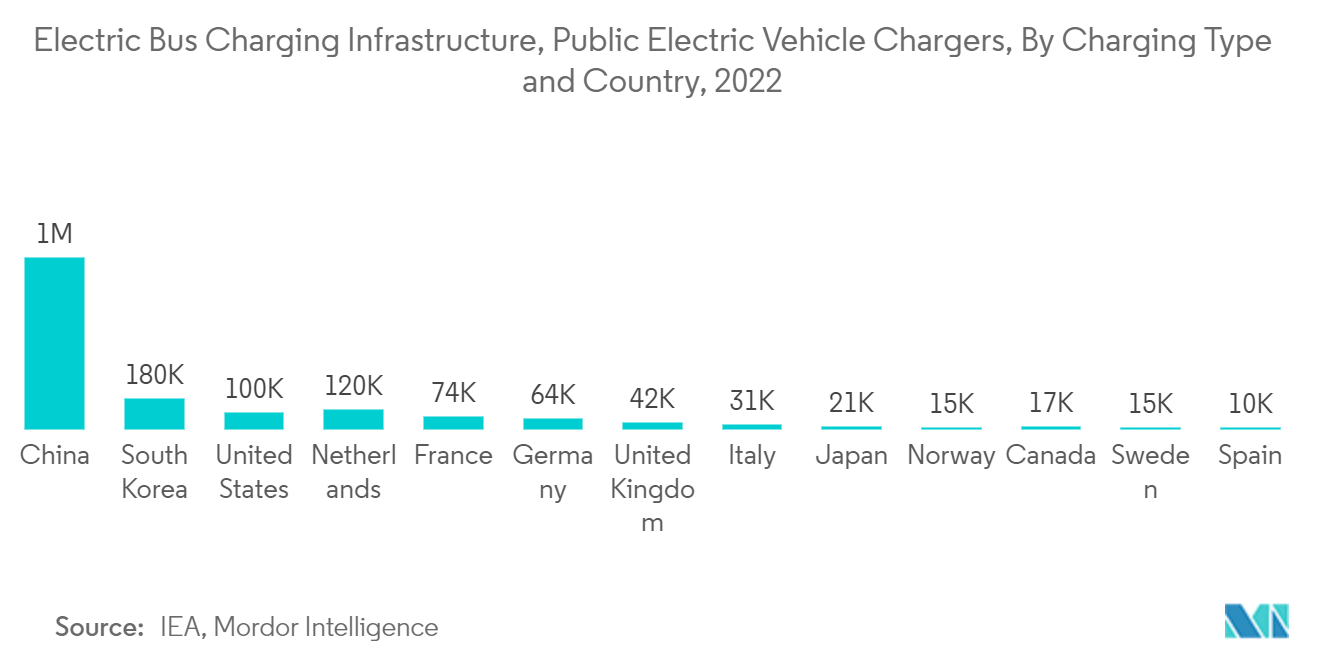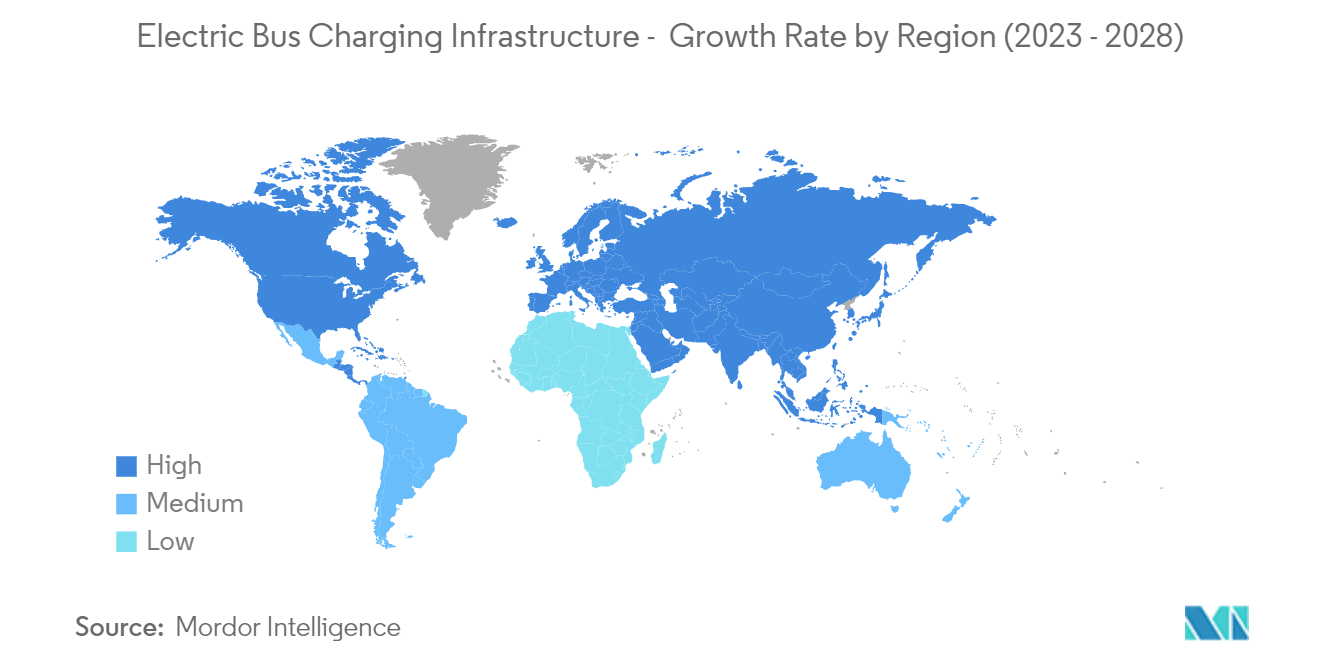Market Trends of Electric Bus Charging Infrastructure Industry
Governmental Efforts to Increase in the Number of Electric Buses Will Boost Overhead Charging Type
- E-mobility is currently seen as the most promising technology to reduce exhaust emissions in transportation. Electric buses are replacing conventional diesel-fueled buses at an accelerating rate that is outpacing the adoption of battery-powered cars. According to forecasts by Bloomberg New Energy Finance, by 2030, ~28% of car sales are likely to be electric vehicles, while 84% of new buses will be electric buses.
- The electric bus market is rapidly growing across the world owing to the governmental push to decarbonize public transportation in major countries. Many countries have established goals to procure electric buses. For instance,
- The Joe Biden administration has proposed a USD174 billion program to promote the adoption of electric vehicles with the goal of moving the United States toward zero-emission transportation. The major market players' innovation in the emerging heavy-duty electric bus sector is boosting the market growth of e-buses by lowering their maintenance costs and efficiency.
- China's move toward electric vehicles is expected to continue, with 420,000 new electric buses expected to be purchased by 2025. Electric bus fleets should be able to grow significantly (about 40%) as a result of market expansion and government support.
- By 2030, India wants to sell 70% of all commercial vehicles, including 40% of buses, as electric vehicles. The objective of achieving net zero carbon emissions is in line with this.
- In Europe, electric bus registrations climbed by 48% in 2021 compared to 2020. Last year, 3,282 e-buses were delivered, increasing the total number of vehicles registered on the continent to over 8,500 since 2012. The European government has formulated various policies and has started projects for building the charging infrastructure across the region, primarily to meet the electric vehicle sales target.
- Governments across nations-initiated changes in the public transportation systems by committing to electrify their bus fleets. Robust government support in the form of subsidies is helping bring the total cost of an electric bus below that of a similar diesel variant, resulting in increased adoption of electric buses across the world. For instance,
- In July 2022, The Mexican government invested USD 38 million in the development of charging infrastructure in the country.
- In July 2022, Canadian Transport Ministry announced new purchase incentives for Medium and heavy-duty zero-emission Vehicles to enhance the electric commercial vehicle sale across the country. The new purchase incentive is worth approximately 50% of the price difference between an electric vehicle and a traditional vehicle.
- The transportation sector, which contributes about 27% to Europe's total greenhouse emissions, is also a source of other dangerous emissions, like NOx. At present, approximately 725,000 buses operate in Europe, including all types of powertrains (electric and non-electric). Out of these, around 2,500 are electric buses, which indicates that the majority of them run on diesel. By 2025, public agencies must purchase "clean" buses for a quarter of all new buses under the new rules that the European Union adopted in February 2019xs.
- From 2030, the ratio will rise to one-third. As a result, bus lines will expand significantly in European cities in the coming years. The C40 Declaration for fossil-free streets has been signed simultaneously by 40 cities, including Paris, Berlin, London, Copenhagen, Barcelona, Rome, and Rotterdam, with the goal of zero-emission bus fleets by 2025.
- With the above mentioned development across the globe is likley to witness major growth for the market during the forecast period.

Asia Pacific is Leading the Electric Bus Charging Infrastructure Market
The electric bus charging infrastructure market in the Asia Pacific is led by China, followed by Europe and North America, respectively. Currently, 99% of electric buses in service are in China, due to the major air pollution problems in Chinese cities and the decision of local authorities to invest in transport that does not emit. Other developing countries like India are fueling the electric bus charging infrastructure market by adopting more electric buses in the country.
China is a key player in the global electric bus market and is home to 98% of the world's electric buses. China is anticipated to sustain its dominance during the forecast period. In March 2021, more than 421,000 electric buses were in use China, which amounts to about 99.0% of the global fleet. The keen focus on electrification of public transit with prevalent subsidies and national regulations is a major factor contributing toward the high market share of China in the global electric bus market.
China's Ministry of Transport is offering subsidies and other benefits for the development of low emission bus fleets, thereby, further positively influencing the market. For instance, 61,000 more new energy buses were sold by Chinese bus makers during 2020, despite of the pandemic.
China's electric bus expansion is expected to continue, with 420,000 additional electric buses ordered by 2025. Growth in the market and government support should also allow for a large increase in the number of electric bus fleets, which is approximately 40%.
Shenzhen and Guangzhou are leading cities in fully electric bus fleets, while more Chinese cities are expected to follow the same in coming years. During the forecast period, China may continue to witness growth in the adoption of electric buses, as more than 30 Chinese cities have made plans to achieve 100% electrified public transit by the start of 2021, including Guangzhou, Zhuhai, Dongguan, Foshan, and Zhongshan in the Pearl River Delta, along with Nanjing, Hangzhou, Shaanxi, and Shandong.
Although China is more focused on battery electric buses, there are significant number of hybrid buses in the country owing to the long-range possibilities offered by them. During the forecast period, series hybrid category is expected to account major share in hybrid bus category. Due to the ease in designing and assembling this type of powertrain, which reduces the overall cost of electric bus, more number od buses are expected to equip this type of powertrain.
Other important countries include India . However, in India, the acceptance of electric and hybrid buses is slow, primarily due to the cost factor. The average cost of hybrid or electric buses is 3-4 times higher than diesel buses. Furthermore, with the decrease in the cost of diesel, there is not much incentive for the operators to shift to hybrid or electric buses. Some cities, like Delhi and Mumbai, are using clean fuel, like CNG, for bus operations.
Thus, to make operators adopt electric buses, the Government of India unveiled the National Electric Mobility Mission Plan (NEMMP) 2020 to accelerate the growth of the electric and hybrid components of the automotive sector. It focuses primarily on fast-tracking the manufacturing and introduction of EVs in India. For instance,
- In September 2022, In India, on behalf of five state governments, CESL-Convergence Energy Services Ltd. (a subsidiary of EESL- Energy Efficiency Services Ltd.) granted a contract for 5,450 electric buses. CESL plans to conduct a $10 billion (Rs.80,000 crore) tender for 50,000 electric buses, which has been authorized by NITI Ayog to reduce pollution in India and boost E-Bus manufacturers.

